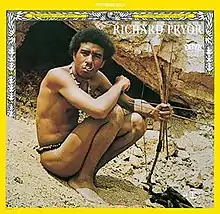Richard Pryor (album)
Richard Pryor is the debut album of comedian Richard Pryor.[1][2] It was recorded live in 1968 at the Troubadour in West Hollywood, California.[1] Gary Burden, an American artist, designed the album cover which was nominated for Best Album Cover at the 12th Annual Grammy Awards[3][4]
| Richard Pryor | ||||
|---|---|---|---|---|
 | ||||
| Live album by | ||||
| Released | November 1968 | |||
| Recorded | September 1968 | |||
| Venue | Troubadour | |||
| Genre | Comedy | |||
| Length | 33:28 | |||
| Label | Dove/Reprise | |||
| Producer | Robert Marchese | |||
| Richard Pryor chronology | ||||
| ||||
Track listing
| No. | Title | Length |
|---|---|---|
| 1. | "Super Nigger" | 3:16 |
| 2. | "Girls" | 3:25 |
| 3. | "Farting" | 2:02 |
| 4. | "Prison Play" | 9:12 |
| 5. | "T.V. Panel Show" | 7:09 |
| 6. | "Smells" | 2:43 |
| 7. | "Army Life" | 4:48 |
| 8. | "Frankenstein" | 0:56 |
Album cover
Gary Burden, who designed the album cover, said Pryor wanted to do something "kind of Roots-y" for the cover.[3] Burden thought "roots" for Pryor would be some kind of tribal or African thing, so he got authentic African artifacts and weapons that fit the idea of a "tribal bushman".[3] Pryor said he knew of a cave right near his home in Beverly Hills that would be an ideal location for the shoot. Burden found charred sticks from a previous fire, and Pryor donned the necklace, belt and the authentic brass nose ring, and posed with the bow and arrow for the cover.[3] After seeing the photos, and how primitive Pryor looked in them, Burden thought they had the look of National Geographic.[3][5] Burden then enlisted his friend Rick Griffin to do artwork that resembled their magazine border, which made the cover look "totally real, like a cover of National Geographic".[3] Burden said that as a result of that cover, he received two letters: "one was a letter from the National Geographic Society’s attorneys offering to sue me for defaming their publication. The second letter was a Grammy nomination for the best album cover".[3] The album was later re-issued with a modified cover, the yellow border was intact, but the inner border of oak and olive leaves was replaced with the Statue of Liberty in what appears to be a lined ruler.[6][lower-alpha 1]
Review
In Scott Saul’s book, Becoming Richard Pryor, Saul opined that in 1968 when Pryor was performing at the Troubadour; "he invented a style that was as far-out as Frank Zappa and as defiant as H. Rap Brown, and was catalyzed by the fusion of the two movements. On the one hand, the freewheeling ethic of the counterculture shaded Richard’s act with irony, making his more political moves seem provisional and subject to revision. On the other, the militancy of the Black Power movement sharpened his zaniness, giving it a point: his improvisations could cut you open with their poignancy or shock you with their bitterness".[7]
See also
Notes
- The modified cover can be seen here - Richard Pryor at AllMusic (click on photo to enlarge); and a side by side comparison of the two covers at National Geographic Collectors Corner.[6]
References
- Sullivan, James (June 8, 2010). Seven Dirty Words: The Life and Crimes of George Carlin. Da Capo Press. p. 115. ISBN 978-0-7867-4592-0.
- Luft, Eric (September 21, 2009). Die at the Right Time!: A Subjective Cultural History of the American Sixties. Gegensatz Press. p. 103. ISBN 978-1-933237-39-8.
- Violet, J. (September 1, 2009). "Richard Pryor". Gary Burden.
- "Gary Burden". Recording Academy - Grammy Awards. 2019-11-19.
Best Album Cover, Richard Pryor (Album)
- Haggins, Bambi (February 2007). Laughing Mad, The Black Comic Persona In Post-Soul America (PDF). Rutgers University Press. p. 51. ISBN 978-0-8135-3984-3 – via Arizona State University.
- Wilson, George Thomas (December 5, 2017). "The National Geographic Society vs. Richard Pryor". National Geographic Collectors Corner.
- Yaffe, David; Saul, Scott (December 10, 2014). "How Richard Pryor Beat Bill Cosby and Transformed America". The Daily Beast.
Further reading
Kreps, Daniel (November 28, 2015). "Classic Richard Pryor LPs Released Digitally for First Time". Rolling Stone.